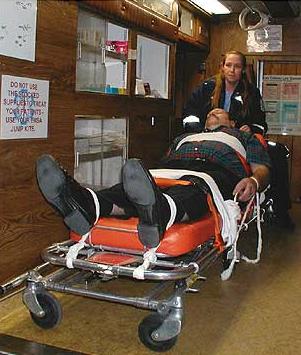Does Canadian health care really stack up so well?
 A new study from the National Bureau of Economic Research questions the alleged superiority of Canada’s nationalized health system in comparison to the United States.
A new study from the National Bureau of Economic Research questions the alleged superiority of Canada’s nationalized health system in comparison to the United States.In Health Status, Health Care and Inequality: Canada VS. the U.S., June O’Neill and Dave O’Neill, of Baruch College, look at several issues regarding the delivery of health services to the general public and what they found will not particularly please some people.
They first argue that the use of infant mortality rate and life expectancy are very poor measures of health care delivery. We explained some of those reasons here. The NBER report also noted that “infant mortality is strongly linked to low birth weight and to preterm births.” This is important because teen mothers tend to have low weight babies and the US has the highest teen pregnancy rate of developed nations and almost 3 times that of Canada. That skews the infant mortality rate in favor of Canada but it not related to the health system.
And when they look the mortality rates within specific birth rates the US actually does as well or better than Canada. Canada does better overall because fewer high risk mothers are giving birth to low weight infants. The NBER study says that if weight distribution in Canada were similar to the US their infant mortality rate would rise to 7.06 which would actually be higher than the rate in the US which is 6.85. There advantage is not health care related but due to the lower rate of teen pregnancies.
Similarly life expectancy is not a gage of health care because it includes things such an accidental deaths and homicides. And there is the fact that Americans are fat. A third of US females are overweight while the rate in Canada is 19%. This impacts life expectancy but obesity is not a result of poorer health care. Fewer calories, up to a point obviously, increases life expectancy.
What this paper prefers to look at are actual indicators of health. What percentage of people with a specific illness obtain treatment for that problem. And they looked at the issue of equality in health care. Does the Canadian system actually deliver less wealthy individuals the same amount of care as it does to the better off and how does Canada compare to the U.S.?
In a self reported health survey 62.5% of Canadians, ages 20 -64, said their health was very good or excellent. In the United States the number was 67.5%. For those over the age of 65 it was 38% of Canadians and 40% for Americans. And one reason could be that Canadians, regardless of the single-payer system, were less likely to actually receive treatment.
In Canada 84.1% of those with high blood pressure were receiving treatment for it. In the United States the number was 88.3%. Those with emphysema or related illnesses are far better off in the US where 72% are receiving treatment versus 52% in Canada. In the US 69.6% of individuals with heart disease receive treatment while in Canada the rate is 67.2%. When it comes to coronary heart disease 84.8% of American sufferers receive treatment as compared to 88.9% of Canadians with the problem. Out of eight conditions they investigated Americans have higher treatment ratios in six categories with Canada leading in asthma and angina. These were for individuals age 18 to 64.
But these differences remain fairly consistent for individuals over the age of 65 as well. The only change was for angina where the U.S. now has a higher treatment rate than Canada: 77.7% to 73%. The report noted that “the U.S. generally performs better with respect to treatment of all conditions except that of asthma.”
What about preventative procedures like PAP smears, mammograms and PSA tests for prostate cancer? Again higher percentages of the American public receive such tests than do Canadians. In the U.S. 88.6% of women ages 40 to 69 have had a mammogram. For Canada it was 72.3%. In the U.S. 74.9% of the woman had the test within the last two years where only 54.7% of Canadian women had a recent test. For PAP smears the rate was, over the last three years, was 86.3% for American woman versus 88.23% for Canadian women. The men get a worse deal in both countries when it comes to testing for prostate cancer. In the same age group, 54.2% of men have been tested while in Canada the rate was an abysmal 16.4%. And testing for colorectal cancer is done, both for men and women, about six times as often in the United States as in Canada.
When the study looked at survival for cancer in both countries they also found that Americans were slightly better off. They looked at the ratio of the mortality rate to the incidence rate for cancers and found that Americans are ahead. They concluded, “in terms of the detection and treatment of cancer, the performance of the U.S. would appear to be somewhat better than Canada’s.”
The use of MRIs and CT scans are also much, much rarer in Canada. Canada has 5.5 MRI scanners per million people as of 2005. The US, in 2004, had 27 per million. When it came to CT scanners the US had 32 per million in 2004 while Canada, for 2005, had 11.3.
Considering that one of the alleged virtues of Canada’s health system is the “equality” factor it is interesting to see that more individuals in the US, with specific conditions, are receiving treatment than do their counterparts in Canada. The report also found that the poor in the United States reported as much, or more health care, than those in Canada did.
This report also noted that waiting time in Canada for care is significantly longer than in the United States. The absence of care, they contend, is more problematic than the ability to pay for the care. As they note “costs may be more easily overcome than the absence of services.” That is, it is easier to find a way to pay for care that is available than to make the care available when it doesn’t exist.
And, when patients in both countries are asked to rate their satisfaction with the care they receive, the typical American, in spite of a reputation for complaining, was happier than the typical Canadian.
The NBER report conclusions basically are these:
Americans have a slightly higher incidence of chronic health problems than Canadians, but they also have higher treatment rates.
The discrepancies between income and health care received has not disappeared in Canada and is actually steeper than in the United States.
More Americans report satisfactory health care than do Canadians.
That some are recommending the Canadian system for the United States seems odd if the NBER report holds up. Even while promoting Canadian style care for the U.S., the New York Times admitted that the “country’s publicly financed health insurance system... is gradually breaking down.” It reported waiting times growing ever longer. And in light of the inability of the Canadian system to provide the care it promised the nation’s Supreme Court ruled that bans on private medical care were unconstitutional and inhumane.
Once the court opened the way for private care Canadians were flocking to the new private alternatives. Even in Quebec, a hotbed of support for socialized care, the premier has announced that the state system will be sending patients to private care facilities for treatment that the state is incapable of providing. In spite of a severe doctors shortage in the country Quebec is still forbidding physicians who provide private care from working in the state system, yet in spite of that regulation, the province has more private clinics than any other province. The Times reported new private clinics opening in Canada at the rate of one per week.
The recently elected head of the Canadian Medical Association, Dr. Brian Day, actually runs one of the largest private hospitals in Canada. And he is planning to open several more. But what started in 1996 with 30 doctors now has 120 physicians on staff. And the provincial state care system has sent them over 1,000 patients for operations that they simply couldn’t do in a timely way.
The Times reports that nationalized health care in Canada has long been “sacrosanct” and “even central to the national identity.” The explosion of private health services there marks a dramatic shift. Antonia Maioni, of McGill University says that there has “been a change in what is feasible and what is permissible in public debates” regarding nationalize health care in Canada. “Five years ago someone like Brian Day would never have been elected president of the Canadian Medical Association. Five or 10 years ago there was much more a consensus about the sustainability of the public system.” Apparently the confidence in that system is waining based on the experiences it is providing.
Labels: Canada, socialized medicine








